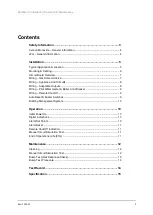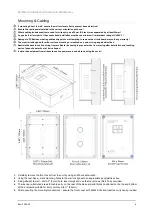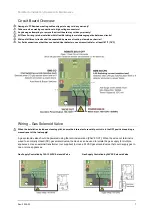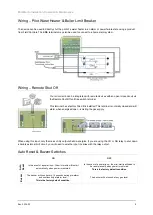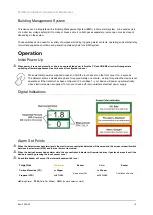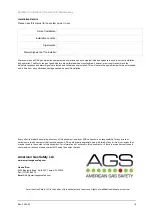
Mini Merlin Installation, Operation & Maintenance
Rev: 03 05-22
4
Carbon Monoxide
–
General Information
Carbon monoxide (CO) is a poisonous, colourless, odourless, and tasteless gas. Although it has no detectable odor,
CO is often mixed with other gases that do have an odor. So, you can inhale carbon monoxide right along with gases
that you can smell and not be aware that CO is present.
SYMPTOMS OF CARBON MONOXIDE GAS POISONING
The following symptoms are related to CO poisoning and should be discussed with all members of the household,
facility or person(s) frequenting monitored areas.
•
Mild Exposure: Slight headache, nausea, vomiting, fatigue, flu-like symptoms.
•
Medium Exposure: Severe headache, drowsiness, confusion, increased heart rate.
•
Extreme Exposure: Unconsciousness, convulsions, cardio-respiratory failure, death.
CARBON MONOXIDE GAS LEVELS
This product is equipped with a digital display that shows levels of CO displayed in PPM (parts per million).
See the specification table for how this product monitors Carbon Monoxide gas.
POSSIBLE SOURCES OF CARBON MONOXIDE GAS
Inside your home or facility, gas appliances used for heating, water heating and cooking are the most likely sources of
CO. Vehicles running in attached garages can also produce dangerous levels of CO.
CO can be produced when burning any fossil fuel, such as gasoline, propane, natural gas, oil and wood. It can be
produced in any fuel burning appliance that is malfunctioning, improperly installed or insufficiently ventilated.
•
Automobiles, gas stoves, water heaters, portable fuel burning heaters, fireplaces.
•
Blocked chimneys or flues corroded or disconnected vent pipes.
•
Burning charcoal or fuel in grills in an enclosed area or near the home.
LPG
–
General Information
Liquefied petroleum gas or liquid petroleum gas
–
(LPG), are constituents of propane and butane, both flammable
hydrocarbon fuel gases used for heating, cooking and vehicles. It is.
•
Obtained during the processing of crude oil, or direct from the sea.
•
Colourless and odourless. An odourising agent is added before distribution.
•
Half as heavy as water when in liquid form. It will float on water before vaporising.
•
Either commercial butane or commercial propane - similar in use but propane has a lower boiling point and
hence a higher storage pressure. Commercial propane is predominantly an outdoor fuel, commercial butane is
predominantly an indoor fuel.
HOW IS LPG COMMONLY USED?
LPG is used in your home, including cooking, heating, hot water, Autogas, aerosol propellant, air-conditioning
refrigerant, and back-up generator applications. LPG used in your home is typically supplied in 45kg LPG gas bottles
and commonly used for BBQ’s and camping.
Business and industry use LPG fuel for a multitude of processes including steam boilers, kilns, ovens, and LPG
forklifts.
WHAT ARE THE HAZARDS OF LPG?
•
LPG is approximately twice as heavy as air when in gas form and will tend to sink to the lowest possible level and
may accumulate in cellars, pits, drains etc.
•
LPG in liquid form can cause severe cold burns to the skin owing to its rapid vaporisation.
•
Vaporisation can cool equipment so that it may be cold enough to cause cold burns.
•
LPG forms a flammable mixture with air in concentrations of between 2% and 10%. Your device is designed to
warn you at 0.16% concentration BV (by volume of air) and will alarm at 0.2% BV
–
this is 8% & 10% of the
Lower Explosive Limit (LEL).
•
Vapour /air mixtures arising from leakages may be ignited some distance from the point of escape and the flame
can travel back to the source of the leak.
•
At very high concentrations when mixed with air, vapour is an anaesthetic and can subsequently asphyxiate by
diluting the available oxygen.
•
A vessel that has contained LPG is nominally empty but may still contain LPG vapour and be potentially
dangerous. Therefore, treat all LPG vessels as if they were full.
For more information, please visit our website or contact your local AGS distributor.


